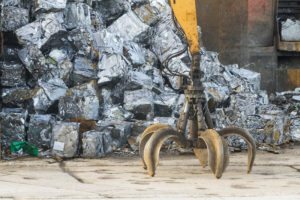 The federal government will invest up to $70 million in a new research institute focused on reducing recycling costs and boosting recycled content in manufacturing.
The federal government will invest up to $70 million in a new research institute focused on reducing recycling costs and boosting recycled content in manufacturing.
The U.S. Department of Energy announced the creation of the Reducing Embodied-energy and Decreasing Emissions (REMADE) Institute, which will be headquartered in Rochester, N.Y. Its goal will be to develop technologies to reduce energy usage and greenhouse gas emissions in manufacturing by improving recycling, remanufacturing and reuse.
REMADE will take up to $70 million in federal funding over five years and match it with private funds to support research into the recycling of metals, fibers, polymers and scrap electronics. The federal money is still subject to Congress and the president approving the funds in a budget.
Consortium members
Some major recycling companies and industry groups are members of the consortium selected by the Department of Energy to run the institute. Among the many members are the following associate member organizations: American Chemistry Council (ACC), The Aluminum Association, American Forest & Paper Association (AFPA), Institute of Scrap Recycling Industries (ISRI), Plastics Industry Association and the Ellen MacArthur Foundation.
“We look forward to working with all consortium members to increase the competitiveness of U.S. manufacturers and to strengthen remanufacturing and recycling as a means to further enhance the overall sustainability of the materials we use,” Steve Russell, vice president of ACC’s Plastics Division, stated in a press release.
In all, the consortium includes more than 100 organizations. Called the Sustainable Manufacturing Innovation Alliance, it is led by the Rochester Institute of Technology.
REMADE will have five different technology nodes, or areas of particular focus. Those include systems analysis and integration, design for reuse/disassembly, manufacturing material optimization, remanufacturing and reuse, and recycling and recovery.
Boosting competitiveness of recycled materials
A press release announcing the creation of the institute notes the energy intensity of extracting raw materials for manufacturing and states that recycling and remanufacturing, defined as the rebuilding of products using reused or recycled parts, can reduce energy consumption.
A primary goal of the institute will be to develop technologies that allow recycled feedstock to be cheaper for use than virgin materials, the document states. To help do that, research will explore technologies to identify desired recycled materials, gather them, sort them and remove contaminants. The technologies won’t be specific to any one material or sector.
A project overview document noted the environmental and financial benefits of using recycled feedstocks but the costs and technical difficulties that can sometimes be encountered in doing so. For example, secondary steel uses 74 percent less energy than primary steel and secondary aluminum 95 percent less energy than primary aluminum. But the costs of secondary feedstocks are higher, according to the document.
“A major technical barrier to increasing use of secondary feedstocks is cost effective identification and removal of trace contaminants like copper, zinc, nickel, vanadium and manganese,” according to the document. “Accumulation of these trace contaminants in recycled materials presents a significant technical challenge to using a higher percentage of recycled metals. The development of new cost-effective physical separation approaches like advanced melting, distillation, and reprocessing techniques or electrochemical separation approaches would apply across different types of primary metals.”


